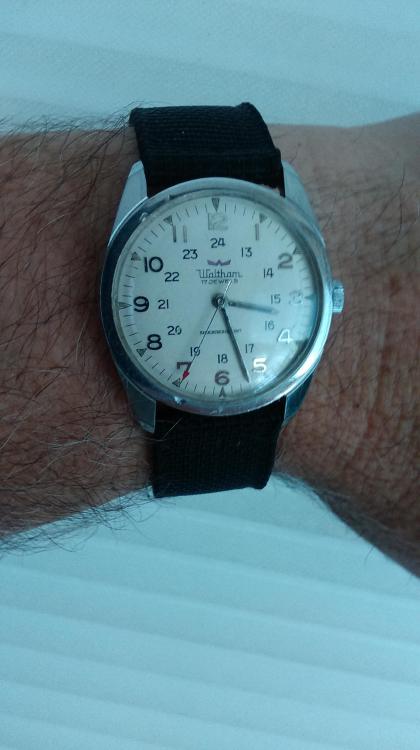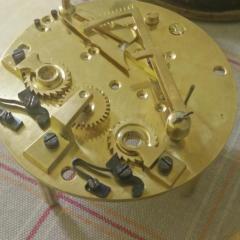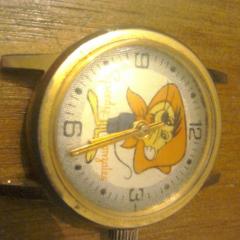Leaderboard
Popular Content
Showing content with the highest reputation on 07/28/19 in all areas
-
Insert the spring. Then, you can hold the barrel down and scoot the end around to drop it in the notch. You have to go "end first", normally clockwise (it'll bind the other way). When it's seated in the barrel but in the arbor and then cap lining up the cap notch.2 points
-
2 points
-
This is an automatic watch. You can replace the broken mainspring with an automatic spring, with integral slipping bridle (brake spring). Or you can use a standard spring with your separate brake spring. Either way you need to grease the barrel wall with braking grease.2 points
-
Probably the brake spring isn't supposed to move so just were it contacts the mainspring. The latter is not greased at all. Only a minimum amount on the barrel and lid flat faces perhaps, even that is optional.2 points
-
Thank you! I will certainly post the completed watch, Mockba 1mchz from the 1950s (I believe), when it's completed!1 point
-
Like most of us, I look for perfection and oiling cap jewels with a regular oiler take a lot of practice and patience. I found myself having to reclean and re-oil over and over before I could approve my work. So, I decided to invest in an automatic oiler for this purpose and although very expensive I think it was worth every penny, and I was so happy about it that I decided to make a video about it. Please bear with me though as this was my very first attempt at video editing.1 point
-
You do not need a heavy oil. The train should be oiled with a good watch train oil. The escapement with a very light oil for escapements Moebius oil is one of the best, go to there site and look at the types of oil and pick the ones they recommend.1 point
-
1 point
-
i would go with a standard spring if that will work. ive had bad luck with watches with a "clutch".. i believe it was pattented by movado years ago. vin1 point
-
That has the look of "apprentice marks". I wonder if the palette bridge gouges and the bent pins are part of a nasty apprentice + screwdriver related incident. Maybe the screwdriver was applied with a little too much youthful exuberance to the screw and afterwards said apprentice checked it still ticked, hastily buttoned it back up and gave it back to the customer. "Nothing to see here sir. Working fine now. That will be fifty bucks. Thank you sir and have a nice day." per the instructions above.1 point
-
Interesting tip in the book called Maintaining & Repairing Mechanical Watches A Practical Guide by Mark W Wiles. So it seems the method VWatchie uses is correct. Page 1481 point
-
WOW! I can't think of a single thing that should be that close to the escapement that would do that. As with the others, I suspect deliberate (klug) activity by a prior servicer. RMD1 point
-
They didn't leave the factory like that. See how it runs, will probably have a big difference in horizontal performance dial up and down.1 point
-
Thanks for clarifying, chaps! Do I still need to lubricate the inside of the brake spring for the main spring? or is it an oil-less system?1 point
-
jdm is correct. That part should not move. so there is no need to do anything. Just oil the m/s with the correct oil.1 point
-
I had to give the Bulova an airing. It may not be the most pristine example in the world, but it runs, which for an 84 year old is no mean feat. I didn't wear it on my trip to Edinburgh today, which was a bit of a mistake, because I found myself with a couple of hours to kill while my wife was off with a friend, enjoying herself as amateur tourist guide and shopping consultant. I took advantage of the time to visit one of my all time best loved places, Chambers Street Museum, or to give it is more formal and modern name "The National Museum of Scotland" I suspect the Bulova would have gone down well with the staff member I was chatting with, who was a bit of a microscopes and horology fan. He hinted that there may be a small horological exhibition coming some time after August, so if you are interested, and live within striking distance of Edinburgh, keep an eye on the Museum website. I did stop and admire one of my favorite clocks of course, one that has fascinated me since I was a kid. It does seem to be wearing its years a little better than my 84 year old though. Click below for more horological fun. https://www.nms.ac.uk/explore-our-collections/collection-search-results/?item_id=211198 I'll need to head back there soon, I'm getting withdrawal symptoms already.1 point
-
1 point
-
1 point
-
Have a google for mobeius oil chart it gives all the lubricants and their uses.1 point
-
Hi What Old Hippy says is good advise clean it up check the running and if ok leave alone. They definitly look as though they have been deliberatly bent for a reason.1 point
-
I would see how it goes first. From the look of the pallet bridge and the screw it has had some very bad treatment. Banking pins are not the sort of thing to play around with, all sorts of problems can happen in and around the escapement.1 point
-
I seriously doubt that to be wear. I looks too deliberate.Plus a person with a watch regularly serviced would not have allowed it to wear so much .It was altered for some purpose and then "repaired".Attend to the movement first, you have some rust issues.then look into that case.1 point
-
Yes, and good luck! BTW, it would be really nice if you can show us the watch once you're done!1 point
-
You'd think no1 is the guy (well, I would too), but in case nobody's noticed watches are weird. Sometimes the most set-a** looking springs trounce a new Nivaflex with all its backcurve fancypantsness. I'd go for no1 but bet the others are darn close in performance if same thickness.1 point
-
1 point
-
Thank you for your introduction and welcome to this friendly forum. Belize, you have some nasty critters.1 point
-
1 point
-
Best method to flatten a coned H/S is to replace it with a new one. You work on coned h/s, in five years time you can,t see the spring without a loup, Within ten years you will need a loup to get in your car and within fifteen two loups to see your house. Joe1 point






.thumb.jpg.57031b8f2c33fad6a29a3b420971c469.jpg)
.thumb.jpg.60328216c4cba399f23b2e218f496d1d.jpg)




